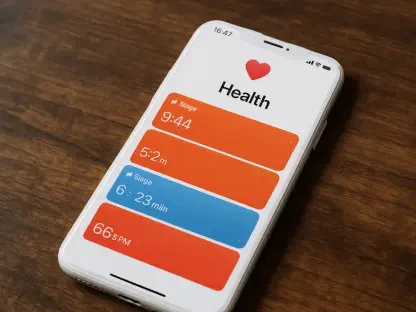In the digital age, where a simple online search can shape critical decisions, healthcare organizations face an unprecedented challenge in building and maintaining patient trust long before a physical visit occurs, making a strong online presence essential. With over 70% of individuals relying on online reviews as a primary factor in selecting healthcare providers, the importance of a robust digital presence cannot be overstated. These reviews, often shared on public platforms, serve as a window into patient experiences and significantly influence perceptions of care quality. A strong digital reputation not only enhances the patient experience but also plays a pivotal role in retention and organizational growth. As healthcare continues to evolve with technology, managing this online narrative becomes a strategic necessity rather than an optional task. The integration of automated tools to handle reputation management offers a solution to the complexities of digital feedback, ensuring that providers can respond effectively and maintain trust in an increasingly connected world.
1. Establishing Trust in a Digital-First Era
In today’s healthcare landscape, the foundation of trust is often laid through digital interactions well before a patient steps into a clinic or hospital. Online platforms have become the first point of contact for many seeking medical services, with a significant portion of potential patients turning to reviews and ratings to gauge the reliability and quality of care. This shift underscores the need for healthcare organizations to prioritize their online image as a core component of patient engagement. A negative review or unresolved complaint can deter prospective patients, while positive feedback can build credibility and attract new ones. The stakes are high, as digital impressions can directly impact an organization’s ability to grow and retain its patient base. Thus, managing these perceptions is not just about addressing criticism but proactively shaping a narrative that reflects commitment to quality care and patient satisfaction in every interaction.
Moreover, the digital realm offers both challenges and opportunities for healthcare providers aiming to establish trust at scale. Unlike traditional word-of-mouth, online feedback is permanent, searchable, and accessible to a global audience, amplifying its impact on decision-making processes. For many patients, a quick search can reveal years of reviews, creating a lasting impression that may outweigh other marketing efforts. Healthcare organizations must therefore adopt strategies that not only monitor this feedback but also respond in ways that demonstrate accountability and care. The sheer volume of online interactions makes manual management impractical, paving the way for automated systems that can efficiently handle this critical aspect of patient relations. By leveraging technology, providers can ensure that their digital presence aligns with the high standards of care they strive to deliver in person, reinforcing trust at every touchpoint.
2. Making Reputation Management a Strategic Focus
Healthcare organizations have historically invested heavily in clinical excellence, operational efficiency, and patient satisfaction to build their standing in the community. However, the rise of digital feedback as an integral part of the patient journey has shifted the landscape, making online reputation management an essential priority rather than a peripheral concern. Patients now share their experiences on various platforms, creating a public record that influences others’ choices and perceptions of care quality. Ignoring or mishandling this feedback can tarnish an organization’s image, even if the in-person care is exemplary. Therefore, reputation management must be treated as a strategic imperative, involving continuous efforts to monitor, influence, and respond to how patients perceive their interactions with healthcare providers.
Beyond mere branding, reputation management in healthcare encompasses a proactive approach to understanding and addressing patient sentiments expressed online. This process requires a commitment to transparency and responsiveness, ensuring that feedback—whether positive or negative—is acknowledged in a way that builds trust. For instance, a timely response to a critical review can demonstrate a dedication to improvement, often turning a dissatisfied patient into a loyal advocate. With the permanence of digital feedback, healthcare organizations cannot afford to overlook its impact on long-term success. Automated tools play a crucial role in this context by enabling providers to track vast amounts of data and act swiftly, ensuring that reputation management aligns with broader goals of patient satisfaction and organizational growth in a competitive market.
3. Harnessing Automation for Feedback Efficiency
The healthcare sector faces unique challenges in managing feedback due to the high volume and sensitive nature of the information shared by patients. Topics such as communication breakdowns, billing disputes, and wait times often surface in reviews, each carrying emotional weight and potential reputational impact. Manually handling this feedback is not only time-consuming but also unsustainable for organizations with limited staff and resources. Automated reputation management tools offer a lifeline by streamlining the collection of reviews, identifying critical issues, and facilitating prompt responses without overburdening frontline workers. These systems ensure that no feedback slips through the cracks, providing a structured approach to maintaining a positive online presence.
Automation also enhances the timing and effectiveness of feedback collection, significantly boosting response rates. By sending requests shortly after a patient visit—when experiences are fresh in mind—organizations can capture more honest and detailed insights. This approach contrasts sharply with traditional methods, such as delayed surveys, which often yield lower engagement. Automated systems ensure that feedback is not only gathered efficiently but also reflects a broader and more accurate representation of patient sentiment. This comprehensive view allows healthcare providers to address concerns proactively and reinforce positive experiences, ultimately strengthening trust and loyalty among their patient base in an era where digital impressions matter immensely.
4. Enabling Swift Responses and Data-Driven Insights
One of the standout benefits of automation in reputation management is the ability to act swiftly on incoming feedback, particularly when it highlights negative experiences. Automated systems can instantly notify the relevant team members about a critical review, enabling follow-up before the issue escalates or results in a lost patient relationship. This rapid response capability often transforms a potentially damaging situation into an opportunity to rebuild trust. By addressing concerns promptly, healthcare organizations demonstrate a genuine commitment to improvement and patient satisfaction, which can resonate deeply with both the reviewer and others who read the exchange online. Such responsiveness is a powerful tool for maintaining a positive reputation in a highly scrutinized industry.
Additionally, automation excels in uncovering patterns and trends within feedback that might otherwise remain hidden. Over time, aggregated data can reveal recurring issues, such as frequent delays in certain departments or consistent communication gaps with staff. These insights provide actionable intelligence for leaders to drive targeted quality improvements and enhance the overall patient experience. Unlike manual processes, which may miss broader themes due to time constraints, automated systems offer a comprehensive analysis that supports strategic decision-making. By leveraging this data, healthcare organizations can prioritize initiatives that address systemic challenges, ensuring that reputation management contributes directly to long-term operational excellence and patient-centered care.
5. Alleviating Staff Burden Through Streamlined Processes
Healthcare workers often face intense workloads, and adding manual reputation management tasks to their responsibilities can contribute to stress and burnout. Automated systems alleviate this burden by eliminating the need for staff to manually track reviews, send follow-up communications, or monitor multiple online platforms. Instead, user-friendly dashboards organize feedback by urgency or category, allowing employees to focus on critical issues without sifting through irrelevant data. This efficiency not only saves valuable time but also enables staff to dedicate more energy to their primary role—delivering high-quality patient care. The result is a more focused and less overwhelmed workforce, better equipped to meet patient needs.
Beyond reducing administrative strain, automation fosters a healthier workplace environment by enhancing overall productivity. When staff are relieved of repetitive tasks, they can engage more meaningfully with patients and contribute to a culture of care and collaboration. These systems also ensure that reputation management becomes a seamless part of daily operations rather than an additional chore. For instance, automated alerts for urgent feedback allow for quick delegation to the appropriate team, minimizing disruption to clinical workflows. By integrating technology in this way, healthcare organizations can support their employees’ well-being while maintaining a strong digital presence, striking a balance that benefits both staff and patients in the long run.
6. Delivering Financial and Operational Gains
Investing in automated reputation management yields substantial financial and operational returns for healthcare organizations striving to thrive in a competitive landscape. A well-maintained digital presence not only solidifies relationships with existing patients but also attracts new ones, directly impacting growth. Studies indicate that hospitals with strong online reputations often generate significantly higher revenue per bed compared to those with poor feedback. This correlation highlights the economic value of a positive digital image, as prospective patients are more likely to choose providers with consistent, favorable reviews. Automation ensures that maintaining this image is both scalable and cost-effective, maximizing its impact on the bottom line.
Operationally, automation eliminates the inefficiencies and expenses associated with manual monitoring processes, saving organizations thousands of dollars annually. Traditional methods often require dedicated personnel or outsourced services to track and respond to feedback, whereas automated tools handle these tasks with minimal ongoing costs. Additionally, the ability to prevent patient loss through timely responses reduces the need for costly acquisition campaigns to replace dissatisfied clients. By integrating automated systems, healthcare providers can allocate resources more strategically, focusing on clinical innovation and patient care improvements while reaping the financial benefits of a robust online reputation that drives sustainable success.
7. Key Steps for Effective System Implementation
Implementing automated reputation management systems successfully requires careful planning and execution beyond simply adopting technology. Optimize Timing for Feedback: Requests should be concise, relevant, and sent soon after patient interactions to capture genuine responses while memories are fresh. Personalize Communication: Even automated messages and responses must feel personal and sincere, ensuring patients feel heard rather than processed. Engage Throughout the Patient Journey: Proactive updates, such as appointment reminders or delay notifications, keep patients informed and respected at every stage. These steps collectively create a seamless experience that enhances trust and encourages honest feedback, setting the foundation for meaningful reputation management.
Further, actionable strategies include: Respond with Empathy: Addressing concerns promptly with genuine care, tailoring replies to specific issues, shows a commitment to resolution. Use Feedback for Continuous Improvement: Regularly analyzing sentiment data and recurring issues enables organizations to implement impactful changes through weekly reports or team debriefs. Train Staff Effectively: Equipping frontline staff with tools and confidence to handle feedback ensures reputation management is a shared responsibility, not an isolated task. By embedding these practices, healthcare organizations can align automation with their values, turning digital feedback into a catalyst for systemic improvement and stronger patient relationships that endure over time.
8. Transforming Patient Feedback into Powerful Advocacy
Positive patient feedback holds immense potential to serve as authentic advocacy for healthcare organizations seeking to stand out. When patients share uplifting stories about their care experiences, especially in their own words, these narratives often resonate more deeply than polished marketing content. With appropriate consent, such testimonials provide a genuine glimpse into what exceptional care looks and feels like from the patient’s perspective. Unlike traditional advertisements, these personal accounts carry an emotional weight that can influence prospective patients more effectively, building a sense of trust and relatability that enhances the organization’s reputation in a meaningful way.
Leveraging these stories requires a strategic approach to ensure they are shared ethically and impactfully. Healthcare providers must prioritize obtaining clear permission to use patient feedback in public forums, respecting privacy and confidentiality at all times. When presented authentically, these testimonials can highlight specific strengths, such as compassionate staff or efficient processes, offering a humanized view of the organization. This approach not only amplifies positive perceptions but also encourages a cycle of goodwill, as satisfied patients become ambassadors who inspire others to choose the same provider. By harnessing patient voices, organizations can create a powerful narrative that reinforces their commitment to excellence in care.
9. Prioritizing Digital First Impressions for Lasting Impact
In the evolving landscape of healthcare, digital reputation stands as a cornerstone of effective patient engagement strategies that cannot be ignored. First impressions formed online often dictate whether a patient chooses one provider over another, making it essential to manage feedback with precision and care. Automation offers the scalability and consistency required to handle vast amounts of data, ensuring that reviews are addressed promptly and trends are identified for improvement. However, the true effectiveness of these tools lies in their integration with an organization’s culture, where technology supports rather than supplants human connection. This balance is critical for maintaining authenticity in digital interactions that shape public perception.
Success in this domain hinges on a commitment to listening and responding to patient voices as a fundamental principle of trust-based care. Healthcare organizations must view digital feedback not as a challenge but as an opportunity to demonstrate accountability and empathy on a public stage. By aligning automated systems with values of transparency and patient-centeredness, providers can create a cohesive experience that bridges online and in-person interactions. As the digital landscape continues to shape healthcare decisions, prioritizing these first impressions ensures that organizations remain relevant and trusted, fostering relationships that withstand scrutiny and build loyalty over time.
10. Reflecting on Actionable Progress and Future Growth
Looking back, healthcare organizations that embraced automated reputation management tackled significant challenges with remarkable efficiency. These systems addressed the overwhelming volume of digital feedback, turning potential setbacks into opportunities for trust-building through swift responses. The reduction in staff burden allowed clinical teams to refocus on patient care, while financial gains from improved reputations underscored the value of this investment. Insights drawn from aggregated data also paved the way for targeted improvements, ensuring that patient concerns shaped operational strategies in meaningful ways. This journey reflected a pivotal shift toward integrating technology with human-centric care.
Moving forward, the next steps involve deepening this integration by refining automation to anticipate patient needs even more proactively. Healthcare providers should explore advanced analytics to predict trends and customize engagement further, ensuring every interaction feels uniquely supportive. Continuous staff training will remain essential to sustain a culture where feedback drives progress. By committing to these actionable advancements, organizations can solidify their digital presence as a true extension of their mission, setting a standard for trust and excellence that inspires confidence in every patient journey ahead.









